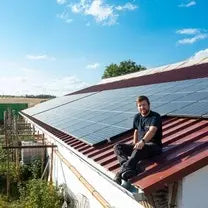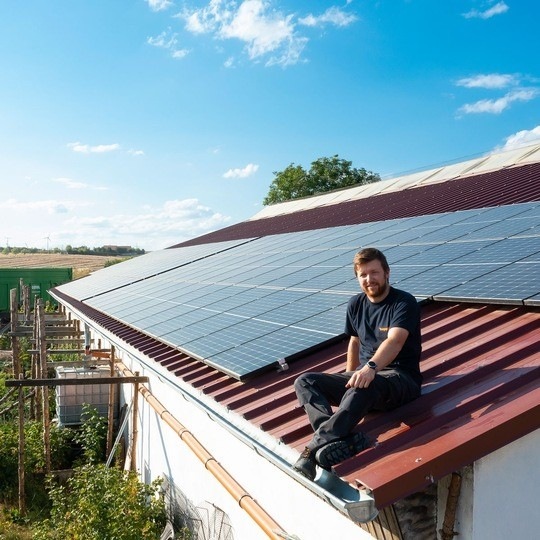The photovoltaic system with Kostal components installed on the roof of the dairy barn in October 2021 is the first solar power system on the Kuhn GbR farm in the Upper Palatinate. He has always been interested in generating his own electricity with photovoltaics. In the first boom period of photovoltaics, it just didn't happen. "We did think about it, but at that time the focus was on feeding electricity into the grid. Now photovoltaics and storage units are part of sustainable farm management," the farmer explains.
Renewable energies are and always have been an issue in agriculture - whether biomass, solar power generation or wind and hydropower. Alexander Kuhn has also always done the math - for the purchase of a photovoltaic and also biogas system. Systems for fermenting liquid manure with an electrical output of up to 100 kilowatts are particularly interesting for dairy farms because they run on 80 per cent liquid manure and only 20 per cent biomass. According to the Kuhn family, the reason for choosing a photovoltaic electricity storage unit is that it is easier to install and commission than a biogas plant. Alexander Kuhn had been thinking about installing a photovoltaic system to generate his own electricity for the family farm for a long time. In 2021, the abolition of the EEG levy on self-consumption for systems with an output of up to 30 kilowatts then brought the breakthrough. "That was only less than 3 cents per kilowatt hour, but enough to run the system economically - with a storage unit."
Room for more self-consumption
According to Kuhn, however, the farm can cope with more generation power for self-consumption: "We consume about 50,000 kilowatt hours per year. Large consumers are milking robots, the milk processing plant with cooling and our groundwater treatment plant." In addition, Alexander Kuhn has exchanged his already aging combustion engine for an electric vehicle, whose batteries are of course charged with photovoltaic power. "50 kilowatts would have suited our consumption well. The 30-kilowatt photovoltaic system with Kostal technology, in combination with the storage unit, currently supplies exactly half of our annual consumption. The 22-kilowatt-hour storage unit lasts us until midnight," explains Alexander Kuhn. "The surplus fed into the grid by the system makes a comparatively small contribution. Here we are continuing to try to increase self-consumption through intelligent consumers."
See also: Luxor Solar KK partners with Next2Sun to realize first Agri-PV project in Japan
After the first nine months, it is clear that the system is working exactly according to plan and is delivering what was calculated: 25,000 kilowatt hours of electricity per year - self-generated for self-consumption and a saving of around 7,000 euros in energy costs at the current electricity price, and the trend is rising.
Expansion to 50 kilowatts is a done deal
The installation was carried out completely by the offering solar installer, an electrical company specialising in photovoltaics and storage units. "The work was done quickly and routinely. It didn't take a week," explains Alexander Kuhn. 375-watt modules were installed, because this meant that exactly 30 kilowatts could be put on the roof.
Also interesting: Farmers opt for photovoltaics to cover their own demand
Alexander Kuhn struggles with the missing 20 kilowatts of photovoltaic power. 50 kilowatts of photovoltaics would make the farm mathematically self-sufficient: "The expansion of the system to 50 kilowatts is already a done deal - actually. The decision for 30 kilowatts was made purely because of the EEG levy. Even though it was only 2.78 cents per kilowatt hour, this has decisively changed the economic efficiency. This also means that we will expand the electricity storage unit so that we have a 1:1 ratio between output and storage. We are also thinking about grid backup power. If you already have PV and storage units, it would be unwise not to do so," the farmer explains. (mfo)


